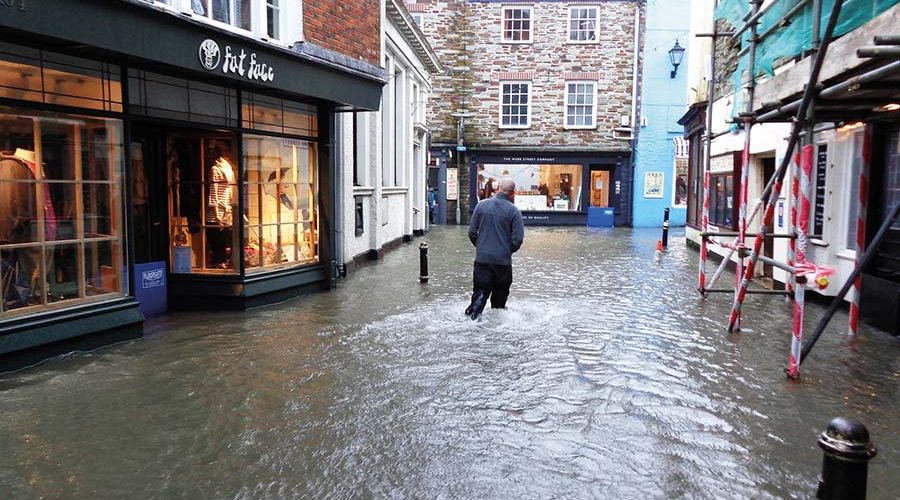Climate change continues to present challenges in the way we plan, develop or redevelop properties across the UK. The effects created by extreme weather conditions, such as increased levels of rainfall in the winter months, is something that cannot be underestimated and, with experts suggesting that we will witness hotter, drier summers, and wetter winters in the future, the issue of flooding is only going to become more prominent in years to come, says Tom Telford, Account Director at Landmark Information.
Landmark
One of the challenges comes from the fact that flooding can occur at any time and in almost any location. Common misconceptions suggest that flooding only happens in the winter months, or if the site is near to a tidal or flowing water source or is located on low-laying ground. This isn’t the case, and it’s important that flood mitigation and resilience measures are factored into all future projects as a matter of course.
If you think back to the start of the year, we saw storms Ciara, Dennis and Jorge creating damage that amounted to a clean-up bill of around £360m according to the ABI1. In fact, February was confirmed as the wettest ever recorded in the UK.
Having access to data insights that provide a clear picture of potential flood risks – both now and in the future – is essential to proactively protect property assets and the communities that live there, from the threat of flooding. There are various different types of flood risk that can occur – these include:
Fluvial flooding
Floods that take place when a river, stream or watercourse is unable to cope with water levels from surrounding land, and fluvial flooding typically occurs following a period of prolonged rain, which has resulted in the land becoming waterlogged.
Pluvial flooding
Surface water flooding that results from heavy rain whereby it overwhelms drainage and creates flash floods in localised areas.
Coastal flooding
Typically results from wet and stormy conditions, high tides or, in the longer term, rising sea levels.
Sewer flooding
When sewage escapes from the pipe through a manhole, drain, or by backing up through toilets, baths and sinks; this is known as sewer flooding. Sewer flooding can be caused by blockages in sewer pipes, equipment failure when water inundates the sewers from storm run-off, or the sewer is too small to deal with the amount of sewage entering it.
Groundwater flooding
Results from an accumulation of water sources, which leads to water levels rising above the natural ‘water table’ levels.
When considering the different risks, surface water flooding is currently said to be a risk for three million properties2. This has the potential to increase in the future as new property developments continue to come to fruition, which creates additional demands on existing drainage with potentially less ‘green space’ where water can naturally drain to. On top of this, we need to also consider the impact climate change may have in relation to such risks.
When analysing pluvial risk data from the FloodFutures National Climate Change Flood Map, which models future flood risk scenarios based on the changing climate, it shows that this number has the potential to increase to over 6.4m residential and 1.45m commercial properties in the 2080s, based on a high emission scenario3.
It is; therefore, important to undertake appropriate surface water drainage assessments and flood risk assessments to fully understand if environmental risks of this nature have the potential to impact build projects in the future.
A good starting point is to access the Environment Agency’s data – or the Scottish Environment Protection Agency for those in Scotland – as it provides a view on current risks relating to many flood risk types for a given area.
For a more specific, address-based analysis, flood risk reports provide more targeted analysis and allow you to ‘zoom in’ on highlighted risks to determine the type, scale and probabilities. They also provide an indication of whether further on-site investigations may be needed.
If this is the case, a physical flood risk assessment by an environmental consultant will provide practical solutions on what actions should be taken to either make existing properties resilient or factor in mitigation measures when designing plans for new developments, if flooding cannot be ruled out in the future.
As data analysis and modelling becomes more sophisticated, the ability to assess future risks is also becoming more dependable.
For example, at Landmark, in partnership with Ambiental Risk Analytics and Wales & West Utilities, we have introduced a national GB dataset that incorporates UKCP09 climate projections to identify the potential impacts of climate change from a flooding perspective.
The dataset includes baseline and future scenario flood maps for the 2020s, 2050s and 2080s, giving developers, urban planners, local authorities and other property professionals the opportunity to effectively glimpse into the future and plan ahead for long-term flood risks with far greater clarity and understanding of how risk profiles will change over time.
Flood risk continues to be one of the most volatile environmental threats that faces Great Britain. It; therefore, is advisable to undertake as much due diligence into what risks may be present today to ensure the appropriate resilience measures are factored in and sustainable drainage systems installed to ensure addresses are not blighted from the impacts of flood waters in the future.
1 https://www.independent.co.uk/news/business/news/flooding-storm-ciara-dennis-insurance-claims-association-british-insurers-a9383111.html
2 https://www.gov.uk/government/news/surface-water-the-biggest-flood-risk-of-all
3 Based on the comparison of a 2017 adjusted baseline 1:100 undefended flooding event and the equivalent under a high emissions UKCP09 scenario. ©2020 Landmark Information Group Ltd & ©2020 Ambiental All rights reserved.









